Journal of Biotechnology Research
Online ISSN: 2413-3256
Print ISSN: 2413-8878
Print ISSN: 2413-8878
Quarterly Published (4 Issues Per Year)

Archives
Volume 6 Number 8 October 2020
Impact of Weather Factors on Coelaenomenodera elaiedis MLK (Coleoptera: Chrysomelidae) in Nigeria
Authors: Aneni T. I. ; Adaigbe V. C. ; Ogbebor C. O. ; Okere C. I. ; Aghayedo C. O.
Pages: 115-128
DOI: doi.org/10.32861/jbr.68.115.128
Abstract
The leaf miner (Coelaenomenodera elaeidis) is a major pest of the oil palm. It breaks out in epidemic proportions periodically, resulting in severe leaf defoliation and consequently low fresh fruit bunch (FFA) yield. This study analyses temperature, rainfall, relative humidity, and leaf miner abundance records sampled in oil palm fields between 1976 and 1980 in the main station of the Nigerian Institute for Oil Palm Research (NIFOR). Data for temperature, rainfall, and relative humidity were obtained from NIFOR meteorological station. Mathematical relationships between the insect stages (larva, pupa, and adult) and weather factors (rainfall and temperature) were developed indicating that pest predictions can be made for different leaf miner stages using their corresponding model equations giving specific values for rainfall and temperature. Variations in the seasonal patterns of temperature and rainfall are of major significance as a cue to timing leaf miner abundance and would help in making better decisions regarding where farmer action can target pest control interventions, thereby contributing to ensure food security. The need for continuous monitoring has great potential for detection and control of insect pests in oil palm growing areas.
Effect of Dietary Supplementation of Albizia lebbeck Seed Oil on the Fatty Acid Composition of Weaner Rabbits
Authors: Alagbe J. O.
Pages: 109-114
DOI: doi.org/10.32861/jbr.68.109.114
Abstract
An experiment was carried out to determine the effects of dietary supplementation of Albizia lebbeck seed oil (ALO) on the fatty acid composition of weaner rabbits. 50 weaned rabbits of mixed breed and sexes, aged between 6-7 weeks with an average initial body weight of 460 ± 1.3 were randomly assigned into five dietary treatments of ten rabbits per group; each group was further divided into 5 replicates consisting of two rabbits each. Basal diet was formulated to meet the nutritional requirements of rabbits according to National Research Council [1]. Rabbits in treatment 1, 2, 3, 4 and 5 were supplemented with ALO at 0 %, 0.1%, 0.2 %, 0.3 % and 0.4 % respectively. Feed and water was given ad libitum and the experiment lasted for 12 weeks. The results showed that significant differences (P<0.05) were observed in saturated fatty acid (SFA), polyunsaturated fatty acid (PUFA) and omega-6/omega -3 ratio (n-6: n-3) values obtained. Rabbits fed diet containing 0.4 % ALO had the highest PUFA value (54.17 %), followed by T4 (53.01 %), T3 (45.13 %), T2 (37.61 %) and T1 (26.93 %) respectively. Similarly (n-6: n-3) composition in T5 (3.65 %) increased in T5 fed 0.4 % ALO compared with T1 (1.38 %) fed 0% ALO. Antherogenic index were significantly (P<0.05) different among the treatments. It can be concluded that supplementation of ALO at 0.4 % highly influenced the composition of fatty acid in rabbit meat.
Microbial Fermentation of Water Melon (Citurullus lanatus) Seeds for Bioethanol Production
Authors: Adegunloye D. V. ; Olotu T. M. ; Sanusi M. B.
Pages: 104-108
DOI: doi.org/10.32861/jbr.68.104.108
Abstract
Watermelon (Citrullus lanatus) is a vine-like flowering originally from Southern Africa. The microbial fermentation of watermelon seeds for me production of bioethanol was investigated. The seeds were washed dried and grounded into powder. The seed powder was then fermented for bioethanol production and the microorganisms responsible for the fermentation were isolated and characterized. Bioethanol was distilled from the fermentation. The distilled bioethanol was subjected to comparative analysis with ’the conventional ethanol. Proximate analysis of the grinded seed was carried out before and after fermentation. The organisms responsible for fermentation were identified as Lactobacillus bulgaricus, Bacillus cereus, Streptococcus lactis, Staphylococcus aureus, Enterococcus sp, Micrococcus spp, Staphylococcus epidermidis, Fusarium oxysporium, Mucor mucedo, Penicillium notatum, Saccharomyces cerevisiae, Aspergillus fumigatus and Aspergillus niger. There was an increase in the protein content of the seed from 4.269% in the unfermented to 10.031% in the fermented. While carbohydrate reduced from 70.523% in the unfermented to 50.149% in the fermented seed. Fat content increased as well as crude fibre content. The distilled bioethanol boils at 78.4% and as a melting point of -112°C at 15°C. The refractive index was 1.360 and the flash point was 12°C. It burns with blue flame. Considering the comparison between the bioethanol produced from Citrullus lanatus seeds with the conventional ethanol, it can be used as an alternative source of biofuel.
Antifungal Activities of Five Commercial Extracts Against Alternaria alternate
Authors: Bachir Raho Ghalem ; Boudali Talia ; Hakem Omar
Pages: 98-103
DOI: doi.org/10.32861/jbr.68.98.103
Abstract
The inhibitory effects of five commercial extracts (Allium sativum, Chamaemelum nobile, Thymus vulgaris, Zingiber officinale and Ricinus communis ) against Alternaria alternata were tested three concentrations (2.5, 5, 12.5 µl/ml) in vitro. T. vulgaris and R.communis extracts both exhibited the most effective antifungal activity against A. alternate with diameter of inhibition zones of 54 mm. The C. nobile extract exhibited a lower degree of inhibition 24.5 to 45 mm at three concentrations. The antifungal indices of T. vulgaris and R.communis extracts at three concentrations against A. alternata were all 98.14%, while this of C. nobile extract was 43.52% at 12.5 µl/ml. The results show that the five commercial extracts have potential for the development of natural antifungal agents, which could be an alternative to chemicals for control of phytopathogenic fungi on fruits or vegetables.



